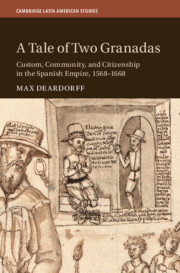Book contents
- A Tale of Two Granadas
- Cambridge Latin American Studies
- A Tale of Two Granadas
- Copyright page
- Contents
- Figures
- Maps
- Tables
- Acknowledgments
- Introduction
- 1 Iberian Antecedents
- 2 Politics, Reform, and the Emergence of Christian Citizenship
- 3 Moriscos, Arabic Old Christians, and Spanish Jurisprudence (1492–1614)
- 4 Cultivating the Christian Republic: The New Kingdom of Granada and the Archbishop Zapata de Cárdenas
- 5 Life in the City: The Casa Poblada and Urban Citizenship
- 6 The Roots of the Mestizo Controversy in the New Kingdom of Granada
- 7 The Mestizo Priesthood
- 8 Mestizo Officials in the Christian Republic
- 9 Urban Indians in Santafé and Tunja, 1568–1668
- Epilogue
- Glossary
- Bibliography
- Index
- Other Books in the Series (continued from page ii)
8 - Mestizo Officials in the Christian Republic
Published online by Cambridge University Press: 27 July 2023
- A Tale of Two Granadas
- Cambridge Latin American Studies
- A Tale of Two Granadas
- Copyright page
- Contents
- Figures
- Maps
- Tables
- Acknowledgments
- Introduction
- 1 Iberian Antecedents
- 2 Politics, Reform, and the Emergence of Christian Citizenship
- 3 Moriscos, Arabic Old Christians, and Spanish Jurisprudence (1492–1614)
- 4 Cultivating the Christian Republic: The New Kingdom of Granada and the Archbishop Zapata de Cárdenas
- 5 Life in the City: The Casa Poblada and Urban Citizenship
- 6 The Roots of the Mestizo Controversy in the New Kingdom of Granada
- 7 The Mestizo Priesthood
- 8 Mestizo Officials in the Christian Republic
- 9 Urban Indians in Santafé and Tunja, 1568–1668
- Epilogue
- Glossary
- Bibliography
- Index
- Other Books in the Series (continued from page ii)
Summary
Chapter eight explores the social legacy of the prior two decades of conflict. The obstinate refusal of the archbishop and cathedral canons to receive a mestizo into the church cabildo had two important outcomes. First, the prejudicial treatment of the mestizos likely led to the closure of the colony’s first seminary. Secondly, it contributed to the emergence of a mestizo consciousness in New Kingdom colonial society among young men from mixed-ethnicity households. In the subsequent decades, this social group began to integrate into many privileged spaces in colonial society. Showcasing major archival discoveries, this chapter makes the case that by the end of the sixteenth century, mestizos already occupied a significant plurality of colonial bureaucratic and ecclesiastical offices.
Keywords
- Type
- Chapter
- Information
- A Tale of Two GranadasCustom, Community, and Citizenship in the Spanish Empire, 1568–1668, pp. 239 - 259Publisher: Cambridge University PressPrint publication year: 2023

